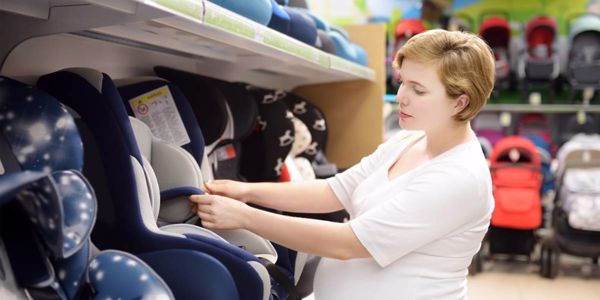As a new or expecting parent, one of the most important purchases you'll make for your little one is their car seat. Ensuring your baby travels safely in the car is key, and with so many options available, navigating the world of car seats can be overwhelming. To help you make your decision, we've compiled a comprehensive guide to help you make the right choice for your precious cargo.
Car Seat Laws
Let's start with the basics: car seat laws. In the UK, it's the law for children to use a car seat until they reach either 135 cm in height or 12 years old, whichever comes first. Babies must use a rear-facing car seat until they weigh at least 9 kg (around 9-12 months old), although it's recommended to keep them rear-facing for as long as possible. Failure to comply with these laws can result in fines and, more importantly, compromises your little one’s safety.
UK Car Seat Safety Requirements to Look For
When choosing a car seat, safety should be your top priority. From 1st September 2023, ECE R129 became the sole standard approved by authorities. This means that EU and UK authorities will no longer accept R44 approvals, except for built-in boosters. As the new EU standard for car seat safety, set back in 2013, regulation ECE R129, was largely brought in to make parents' lives easier and make it more clear when children should be moved onto a new seat or facing a different direction.
Since the EU brought in ECE R129 regulation, it has been in place alongside the existing ECE R44, and car seats have been able to be manufactured and sold, provided that they pass either of the two safety standards. R129 compatible seats allow parents to choose their child's seat and position based on their height rather than weight. This makes things easier for parents to establish the right seat setting and is the best way to ensure that children are always in the right seat for the correct length of time.
R129 seats are often known as i-size seats, but it's important to remember that i-size is an enhancement of R129. All i-size car seats are R129 approved, but not all R129 seats are i-size.
Additionally, opt for seats that have undergone rigorous crash testing and have a good safety record. Some seats may also feature additional safety features such as side impact protection or adjustable harnesses for a secure fit.
Read More: Car Seat Law Changes – What You Need to Know
Isofix Explained
Isofix is a system designed to make installing car seats easier and safer. It involves anchor points built into the car, which the car seat attaches to directly. This eliminates the need for seat belts to secure the seat, reducing the risk of incorrect installation. Most modern cars are equipped with Isofix points, so be sure to check if your vehicle is compatible before purchasing a car seat.
I-Size Explained
I-Size is a newer regulation that focuses on keeping children rear-facing for longer, as it's widely acknowledged that rear-facing seats offer better protection in the event of a crash. I-Size seats are classified by height rather than weight, making it easier for parents to choose the right seat for their child. While not all car seats adhere to the I-Size standard, opting for one that does provides an extra layer of assurance.
Read More: Best Newborn Car Seats of 2024
Car Seat Groups Explained
Car seats are divided into groups based on the weight of the child they're suitable for.
- Group 0, 0+ - Also known as infant carriers, these are safe for babies from birth to 13kg (0+), or 10kg (0). This is approximately 12 months.
- Group 1 - Children from 9kg to 18kg are suitable from around 9 months to 4 years.
- Group 2 - These are booster seats for children from 15kg upwards, which is approximately aged 4 onwards.
- Group 3 - Booster cushions for children 22kg upwards, approximately age 6 and more than 125cm tall.
Are Rear Facing Car Seats Safest?
Yes, rear facing car seats are now considered to be safer provided that your little one hasn’t outgrown the seat. Rear-facing car seats provide superior protection for your baby's head, neck, and spine in the event of a collision. This is because they distribute the force of impact more evenly across the body, reducing the risk of injury. Many experts recommend keeping your child rear-facing for as long as possible, ideally until they outgrow the seat or reach the maximum weight limit.
Read More: The Ultimate Guide to Car Seat Safety
Will Car Seats Fit in Any Car?
While most car seats are designed to fit in a wide range of vehicles, it's always a good idea to check compatibility before making a purchase. Factors such as the shape of your car's back seats, the presence of Isofix points, and the size of the backseat area overall can all impact whether a car seat will fit properly. Many retailers offer fitting services or allow you to try before you buy, so take advantage of these options to ensure a snug and secure fit.
Do You Want a Car Seat That is Travel-System Compatible?
If you're a parent on the move, you might be considering a travel-system instead of a separate pushchair and car seat. If so, make sure to look for brands that offer car seats as part of a wider travel system that meets all of your needs, or car seats that are compatible with travel systems and can be used with an adaptor.
Read More: Travel System Buying Guide
Can I Buy a Second-Hand Car Seat?
While it may be tempting to save money by purchasing a second-hand car seat, it's not recommended. Car seats have an expiration date, typically around 6-10 years from the date of manufacture, after which they may no longer offer adequate protection. As well as this, you can't be sure of a second-hand seat's history, whether it's been involved in an accident or if it's been properly maintained. For peace of mind and your child's safety, it's best to invest in a new car seat.






